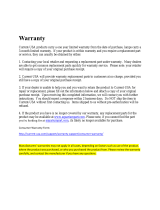
15OPERATION
ENGLISH
CAUTION
• Do not overfill or pack items too tightly into door
bins. Doing so may cause damage to the bin
or personal injury if items are removed with
excessive force.
• Do not store glass containers in the freezer.
Contents may expand when frozen, break the
container and cause injury.
NOTE
• If you are leaving home for a short period, like a
short vacation, the refrigerator should be left on.
Refrigerated foods that are able to be frozen will
stay preserved longer if stored in the freezer.
• If you are leaving the refrigerator turned off for
an extended period, remove all food and unplug
the power cord. Clean the interior, and leave the
doors open to prevent fungi from growing in the
refrigerator.
• Do not store food with high moisture content
towards the top of the refrigerator. The moisture
could come in direct contact with the cold air and
freeze.
• Wash food before storing it in the refrigerator.
Vegetables should be washed, and food packaging
should be wiped down to prevent adjacent foods
from being contaminated.
• If the refrigerator is kept in a hot and humid
place, frequent opening of the door or storing a
lot of vegetables in the refrigerator may cause
condensation to form. Wipe off the condensation
with a clean cloth or a paper towel.
• If the refrigerator door or freezer drawer is opened
or closed too often, warm air may penetrate the
refrigerator and raise its temperature. This can
increase the running costs of the unit.
Food Storage Tips
Wrap or store food in the refrigerator in airtight and
moisture-proof material unless otherwise noted. This
prevents food odor and taste transfer throughout the
refrigerator. For dated products, check date code to
ensure freshness.
Food How to Store
Butter or
Margarine
Keep opened butter in covered
dish or closed compartment. When
storing an extra supply, wrap in
freezer packaging and freeze.
Cheese
Store in original wrapping until
used. Once opened, rewrap tightly
in plastic wrap or aluminum foil.
Milk
Wipe milk cartons. For coldest milk,
place containers on an interior
shelf.
Eggs
Store in original carton on interior
shelf, not on door shelf.
Fruit
Do not wash or hull fruit until it
is ready to be used. Sort and
keep fruit in original container in
a crisper, or store in completely
closed paper bag on refrigerator
shelf.
Leafy
Vegetables
Remove store wrapping, trim or
tear off bruised and discolored
areas, wash in cold water, and
drain. Place in plastic bag or plastic
container and store in crisper.
Vegetables with
skins
(carrots,peppers)
Place in plastic bags or plastic
container and store in crisper.
Fish
Freeze fresh fish and shellfish
if they are not being eaten the
same day purchased. Eating fresh
fish and shellfish the same day
purchased is recommended.
Leftovers
Cover leftovers with plastic wrap
or aluminum foil, or store in plastic
containers with tight lids.




















